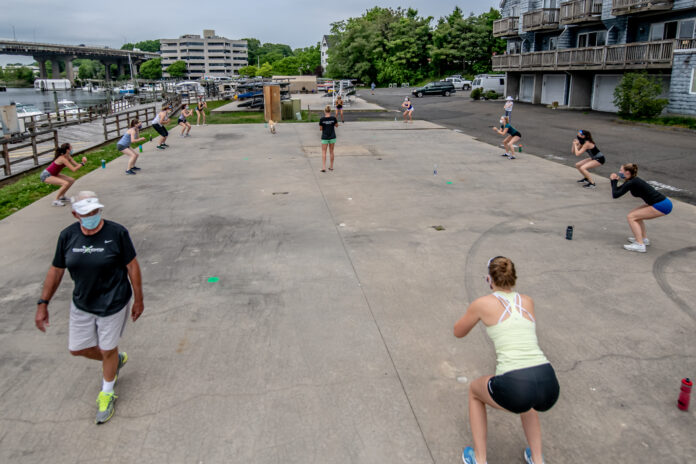BY ANDY ANDERSON
PHOTO BY ED MORAN
To continue reading…
This article is exclusively for Rowing News subscribers. For as little as $5 a month, you can get access to the best quality, independent reporting on all the issues that matter to the North American rowing community.
Already a subscriber? Login
When my family and I moved into our house in 2000 and I began to unpack some of the rowing memorabilia I had gathered over the years, I was given to understand that the living room was not an appropriate place to display it. Instead, a few treasured rowing items were placed where I would see them frequently. As I write, this photo of the 1986 U.S. lightweight women’s team sits on my desk, and I admire it all the time. It was taken in Nottingham, England, on a day before the World Championships racing began. A friend of one of the athletes orchestrated the photo shoot. I’m sure there were posed photos of the team with serious expressions, but this photo, taken at the end, was one of the fun ones.
“On my count,” photographer Janet Beroza said, “jump up as high as you can. 1, 2, 3, jump!”
It’s my favorite photo from my nine years as a national team coach. Of course, it helps that the straight four, the boat I coached, won the gold medal. And so did the double scull. Our single sculler was third. All six of those athletes are leaping into the air for joy, and remember, this was before they had earned their medals. I like it because it shows their jubilation at having made the team, trained successfully, and traveled to a World Championships prepared to do their best. Even the three spares look happy. (And being a spare is about the hardest role for a superb athlete. To get so close….) I’m not sure why the single sculler is not with the rest of her teammates.
Over the years, as I’ve studied these nine women in midair, I’ve wondered about the differences in how high they got off the ground. It goes without saying that they were all terrific athletes. Three of the women in the four are way up there, but one, in socks, looks like she might be a half-inch high. And second from the left, one of the most successful lightweight scullers ever to race for the USA also looks earthbound. It’s certainly possible that one of them jumped a little early and was already on the way down when the shutter snapped. But it’s also possible that the exhortation I’ve often barked through my megaphone — “Jump on it!” and “Jump off the foot stretchers!” — doesn’t have much to do with success in driving the legs and making a boat go fast. It’s not how high the jump; it’s the coordination and timing that are most important.
In the 1980s, a new type of training, plyometrics, entered rowing. Created by Russian scientist Yuri Verkhoshansky for track and field, it was based on the premise that bounding on and off a raised platform, such as a box 18 inches high, would develop ballistic power and explosive strength in the legs.
I’ve often wondered what early adopters of plyometrics thought about its value for rowing. So I turned to old friend and cerebral coach Larry Gluckman.
“First of all, I would not do anything unless I could figure out a way of testing the effectiveness of a prescribed activity,” he said. “So, in the case of box jumping, I would use either a dynamometer or leg-press machine to establish a baseline and then create a program with frequent tests, either in terms of speed of drive or total weight lifted.
“At Princeton and Dartmouth in the ’80s and early ’90’s, I did some plyometrics but at that time I lacked any empirical evidence, so the activity did not provide me anything objective. From a visual standpoint, I thought we were more engaged at the point of the entry and beginning of the leg drive. I would draw the conclusion that the timing of jump from box to floor to box was not unlike from entry to leg drive. There was more of a motor-learning experience than an obvious improvement in power.”
Many rowing programs use “jumpies,” which are related to plyos but without the box. For Gluckman, plyos and jumpies are useful not so much for building strength as improving cardio, motor learning and mental toughness. He also advocates broad jumps for total-body awareness, balance, and explosive coordination.
“Let the athletes jump the length of an eight and see how many can nail consecutive jumps without losing balance, upper- and lower-body coordination and a sense of flow.”
As for the athletes in my cherished photo?
“I really enjoyed plyometrics,” said Sandy Kendall. “In a love-hate kind of way.” (They burn.)
Mandi Kowal, the highest leaper in the picture and a rowing and triathlon coach now, said, “I loved the feeling of jumping; it was not hard on the body, and I had to be explosive. With jumpies, I found that establishing a rhythm was critical to being successful.
“When I teach beginners, we do super slow-mo down in order to mimic going into the catch, which then translates to better squats and the right approach at the transition point in the squat [at the bottom and coming back up] – similar to the catch. Also, I watch to see that their knees track over their toes. Once I see them establish great technique, we bring the rating up.”
About Carolyn Mehaffey, the woman in socks, Mandi said: “Carolyn brings nice long levers, a great feel for the water, and calm competitive forces that are a gift for any boat. She’s what we call a low-maintenance, high-return athlete.”
Do you do jumpies? If so, pay attention to technique, to rhythm, and to rating. Sounds just like rowing, right?

